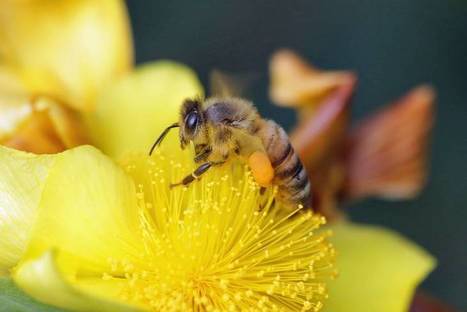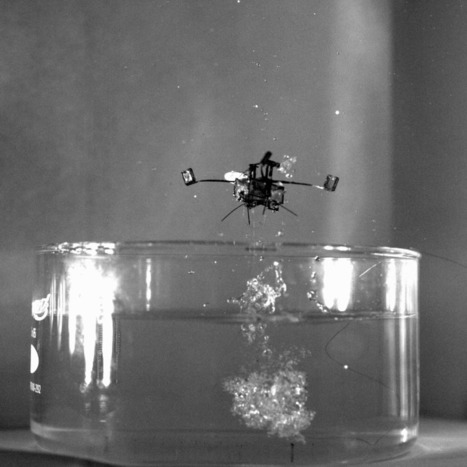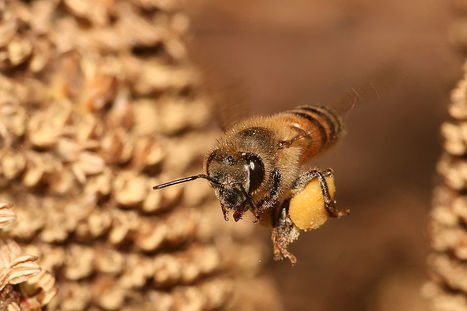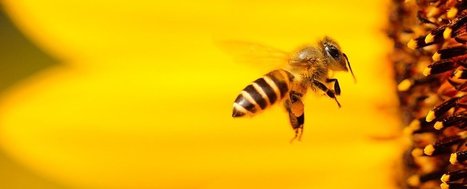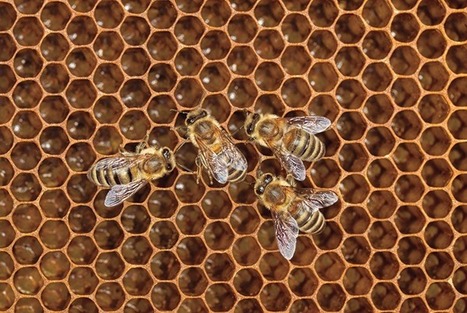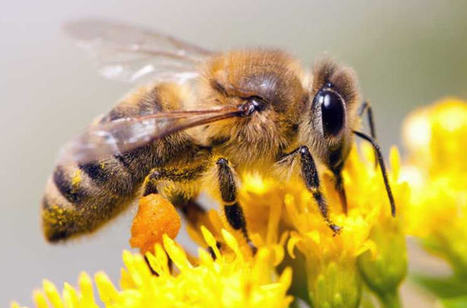 Your new post is loading...
 Your new post is loading...
Computer engineers study the mathematics of how to optimize complex systems. In one example, they face a logistics challenge known as the "travelling salesman problem:" how can a hypothetical salesperson visit every city on their route in the shortest distance? The algorithms developed to answer these sorts of questions are useful in many situations, such as reducing the costs of and pollution from a fleet of delivery trucks. But when engineers tried to optimize traffic on the internet, they found their methods wanting. [...] Honeybees don't study mathematics, but the demands of evolution reward those colonies that succeed in optimizing their resources. Fortunately, in the strange tale of how honeybees make the internet work, the scientists were smart enough to see that the honeybees knew better than they did.
"What’s better than a robot inspired by bees? A robot inspired by bees that can swim.Researchers led by a team at Harvard University have developed a tiny, 175-milligram (about two feathers) device with insect-inspired wings that can both flap and rotate, allowing it to either fly above the ground or swim in shallow waters and easily transition between the two."
"Researchers from the University of Granada (UGR) have designed an algorithm, inspired by the intelligent and social behavior of bee colonies, which allows law enforcement to attack and dismantle any type of social network that poses a threat, whether physical or virtual, such as social networks linked to organized crime and jihadist terrorism."
"Wind turbines produce 4% of the planet’s energy, but they only work well when the wind is blowing just right. Now, by drawing inspiration from the flexible wings of insects, scientists have found a way to make wind turbine blades 35% more efficient at producing energy. If commercialized, the advance could make this green technology a more viable alternative to fossil fuels in the coming years."
Bees control their flight using the speed of motion (optic flow) of the visual world around them. A study by Scientists at the University of Sheffield Department of Computer Science suggests how motion-direction detecting circuits could be wired together to also detect motion-speed, which is crucial for controlling bees’ flight.
“Honeybees are excellent navigators and explorers, using vision extensively in these tasks, despite having a brain of only one million neurons,” said Alex Cope, PhD., lead researcher on the paper. “Understanding how bees avoid walls, and what information they can use to navigate, moves us closer to the development of efficient algorithms for navigation and routing, which would greatly enhance the performance of autonomous flying robotics,” he added.
"Energy storage could be the next item on the list when it comes to listing all the reasons we need to save the world's bee population from collapse. A research team at Purdue University has found that bee pollen can be used as an efficient, renewable source for anodes in lithium-ion batteries. The team also tested pollen sourced directly from cattails and got even more encouraging results."
"When it comes to managing a building’s cooling and heating costs, just look up. It turns out there’s a lot to be learned from the birds and the bees, according to Toronto-based REGEN Energy. The clean tech firm co-ordinates HVAC (heating, ventilating and air-conditioning) systems by tapping into the ability of insect colonies and flocks of birds to display a greater collective intelligence."
"Australian neuroscientists studying bees' flight have uncovered a surprisingly simple guidance strategy which could be used by drones, stealth fighters and even spacecraft. Experiments at the Australian National University revealed that bees land safely by ensuring that the surface they are approaching expands at a constant rate within their field of vision."
"When bees fly through the air outside the hive, they collide with charged particles, from dust to small molecules. These impacts tear electrons away from their cuticle—their outer shell—and the bee ends up with a positive charge. When they return to the hive and walk or dance about, they give off electric fields. And Uwe Greggers from the Free University of Berlin has shown that they can detect these fields with the tips of their antennae. Despite our long history with the honeybee, there could still be a secret world of electric communication within the hive that we know nothing about."
|
Photo details: Apis mellifera by Muhammad Mahdi Karim (www.micro2macro.net) Facebook Youtube), GFDL 1.2, via Wikimedia Commons
"New research on how bees perceive colour could be put to good use in our digital cameras, meaning photos shot by drones or phones would look more natural than ever. It's all to do with colour constancy, the way that bees (and humans) can tell a flower is red no matter what the colour or quality of the light – a mental trick that the digital cameras of today really struggle with."
"This robotic bee drone prototype gives bees a hand in pollinating flowers and could be a solution to the dwindling bee population. [...] Part-awareness rising project, part-potential solution to a very real problem, Plan Bee is a self sustainable drone that stimulates the growth of plants by cross-pollination. The drone sucks pollen through tiny holes located underneath and then pushes it back out through the vents on top. As the drone flies over the field, the pollen will fall on the flowers nearby. The device is also equipped with a UV camera to locate the flowers."
"For a delivery truck making rounds, minor tweaks in a route can save huge amounts of time and gas. That's why UPS spent a decade and hundreds of millions of dollars building an algorithm to help calculate where trucks should turn. A startup called Routific designed an algorithm to help everyone else—like local flower delivery companies—also save fuel. To help find the best routes, they took inspiration from bees. Their algorithm is based on the "bees algorithm," which describes how bees find the best route to flowers. Scout bees fly long distances in random directions, and if they find food, they fly back and buzz around in the so-called "waggle dance" to notify everyone else. When others go to the same location, they'll come back and waggle even harder if they find a better spot."
Photo details: Apis mellifera by Muhammad Mahdi Karim (www.micro2macro.net) Facebook Youtube), GFDL 1.2, via Wikimedia Commons
"How do bees do it? The honeycombs in which they store their amber nectar are marvels of precision engineering, an array of prism-shaped cells with a perfectly hexagonal cross-section. The wax walls are made with a very precise thickness, the cells are gently tilted from the horizontal to prevent the viscous honey from running out, and the entire comb is aligned with the Earth’s magnetic field. Yet this structure is made without any blueprint or foresight, by many bees working simultaneously and somehow coordinating their efforts to avoid mismatched cells."
"Almost anything that flies, be it a plane, a spacecraft, or a drone, has an inertial navigation system with accelerometers and gyroscopes that control yaw, pitch and roll, and thus the flight path. Flying insects like bees, however, don't have inertial systems to guide them; they rely exclusively on what they see. This has inspired two researchers at the Aix-Marseille University in France to build a drone that imitates the way these insects navigate. Their mission was to design it to fly and circumvent obstacles by relying solely on visual cues. "
"Michael Papay, chief executive at Bay Area startup Waggl, said his app is inspired by (and named after) the decision making dance that honeybees have used for millions of years.”
"Honeybees are social insects, always exchanging information with each other for the success of the hive. When a bee finds an attractive new flower with a good supply of pollen, it flies back to the hive and performs a sophisticated waggle dance for the other bees, communicating the distance and direction of the flower from the hive, the type of flower it is, and the potential magnitude of the find. Other bees watch this dance, then navigate to the flower themselves to harvest more of its pollen, which is good because producing a single pound of honey requires roughly two million bee-loads of pollen. So now imagine for a moment that your company operates a flowerbed, and you are in the business of “selling” your pollen to bees. Your first task is to attract an exploring bee to land and take a look, and for that you need to be sure that your colors are bright and your scent is attractive. That’s advertising. But the bee is part of a social network, so when it returns to the hive after visiting your flower it’s only going to send for the other bees if your pollen was good. And that’s customer experience."
"At the Fraunhofer Institute for Material Flow and Logistics IML in Dortmund, Germany, researchers are working to harness swarm intelligence as a means of improving the flow of materials and goods in the warehouse environment."
|



 Your new post is loading...
Your new post is loading...

